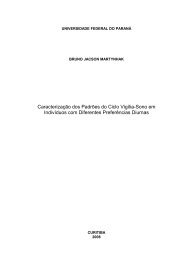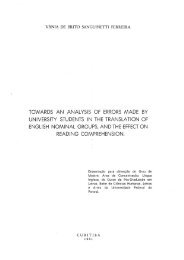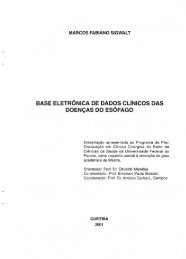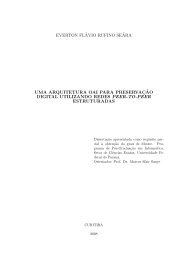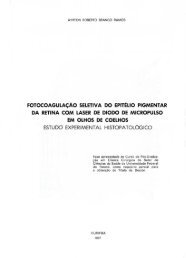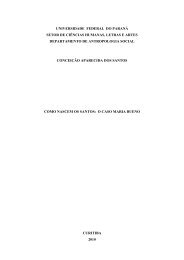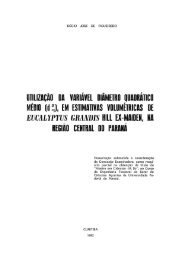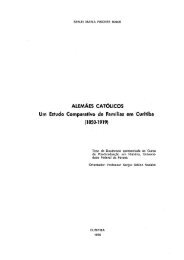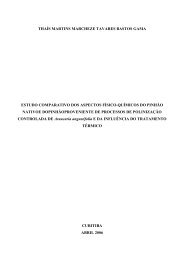identificação e manejo de nematóides da bananeira - Universidade ...
identificação e manejo de nematóides da bananeira - Universidade ...
identificação e manejo de nematóides da bananeira - Universidade ...
You also want an ePaper? Increase the reach of your titles
YUMPU automatically turns print PDFs into web optimized ePapers that Google loves.
Em Londrina, PR, CARNEIRO et al. (2003) constataram M. javanica<br />
causando <strong>da</strong>nos em A. pintoi. Através do estudo, os autores verificaram tratar-se <strong>de</strong><br />
uma nova raça para qual propuseram a <strong>de</strong>nominação <strong>de</strong> M. javanica raça 4.<br />
Portanto, com base nessa informação e como a <strong>bananeira</strong> não é um<br />
hospe<strong>de</strong>iro preferencial <strong>de</strong> M. hapla (JONATHAN, BARKER e SUTTON, 1999), A.<br />
pintoi po<strong>de</strong>ria ser recomen<strong>da</strong><strong>da</strong> como planta <strong>de</strong> cobertura para a <strong>bananeira</strong>, visando<br />
minimizar os efeitos prejudiciais <strong>de</strong> nematói<strong>de</strong>s, somente em áreas não infesta<strong>da</strong>s por<br />
R. similis (ARAYA e CHEVES, 1997b) e/ou por M. javanica raça 4, já que esses<br />
nematói<strong>de</strong>s se reproduzem no amendoim forrageiro.<br />
SUNDARARAJU, SHANTHI e SATHIAMOORTHY (2003), verificaram<br />
que crotalária, Crotalaria juncea L, intercala<strong>da</strong> à banana, reduziu a população <strong>de</strong> R.<br />
similis e aumentou o crescimento e rendimento <strong>da</strong> <strong>bananeira</strong>.<br />
Populações <strong>de</strong> R. similis e P. coffeae foram reduzi<strong>da</strong>s nas raízes <strong>de</strong> banana<br />
quando consorcia<strong>da</strong>, por quatro meses, com Tagetes sp., alfafa, Medicago sativa L.,<br />
Crotalaria juncea ou coentro, Coriandrum sativum (NAGANATHAN et al. 5 , citado<br />
por FERRAZ e FREITAS, 19--). Quando banana foi consorcia<strong>da</strong> com seis fileiras <strong>de</strong><br />
T. erecta ou T. patula, as populações <strong>de</strong> Meloidogyne, Radopholus e Pratylenchus<br />
diminuíram e as raízes foram menos <strong>da</strong>nifica<strong>da</strong>s (SUPRATOYO 6 , citado por FERRAZ<br />
e FREITAS, 19--).<br />
No Quênia, CHARLES 7 , citado por FERRAZ e FREITAS (19--) testou o<br />
consórcio <strong>de</strong> banana com Coriandrum sativum, Sesamum indicum, Crotalaria juncea,<br />
Tagetes erecta e Acorus calamus como alternativa para a aplicação <strong>de</strong> carbofuran.<br />
Compara<strong>da</strong>s à testemunha, to<strong>da</strong>s as antagonistas reduziram as populações <strong>de</strong> R.<br />
similis, R. reniformis, M. incognita, H. multicinctus e Hoplolaimus indicus.<br />
5 NAGANATHAN, T. G., ARUMUGAM, R.; KULASEKARAN, M. e VADIVELU, S.<br />
Effect of antagonistic crops as intercrops on the control of banana nemato<strong>de</strong>s. South Indian<br />
Horticulture v. 36, n.5, p. 268-269, 1988.<br />
6 SUPRATOYO, M. Studies on the effect of Tagetes erecta and Tagetes patula for<br />
controlling plant parasitic nemato<strong>de</strong>s on banana. Ilmu Pertanian v. 5, n. 3, p 681-691, 1993.<br />
7 CHARLES, J. S. K.. Effect of intercropping antagonistic crops against nemato<strong>de</strong>s in<br />
banana. Annals of Plant Protection Sciences v. 3, n. 2, p. 185-187, 1995<br />
28



